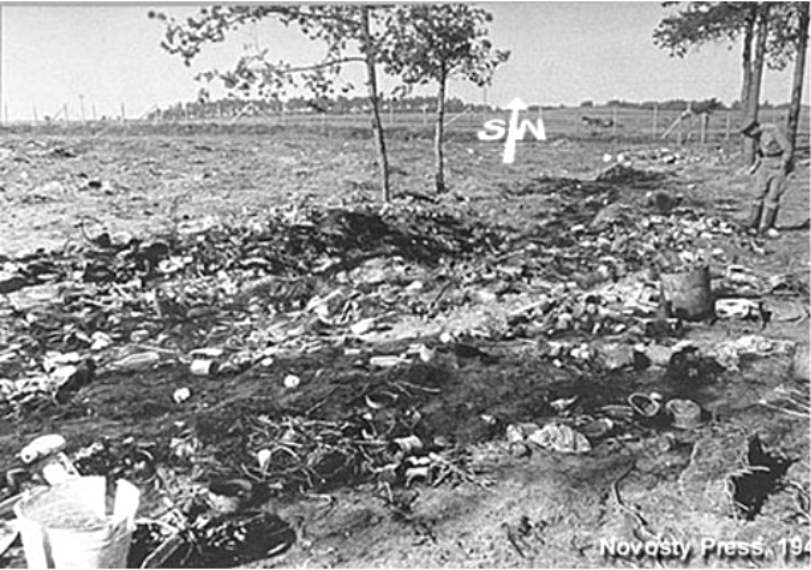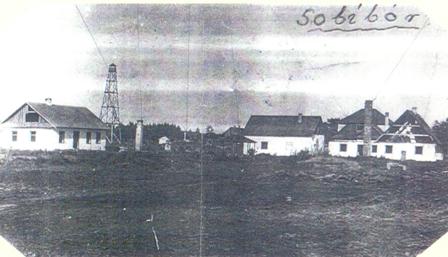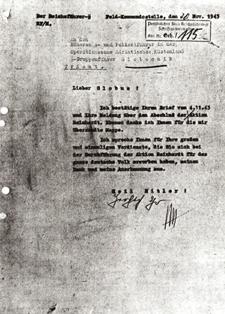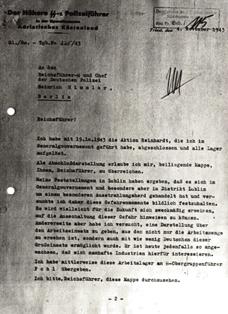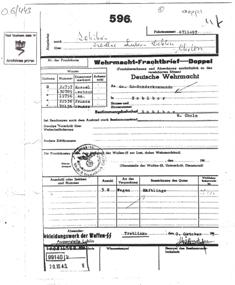Holocaust Education & Archive Research Team |
Aktion Reinhard
A-R Leadership A-R Articles
Action Erntefest Modern Research
| ||||
The Conclusion to Aktion Reinhard Heinrich Himmler the Reichsfuhrer –SS visited Lublin in March 1943 and toured the death camps of Sobibor and Treblinka, it became clear that the Aktion Reinhard death camps had fulfilled their gruesome task, and that virtually all of the Jews in the General Gouvernment had been exterminated.
The SS were determined to erase all traces of their crimes, and Himmler ordered all the corpses to be exhumed and cremated. In addition the camp structures were to be destroyed the area ploughed over, and trees to be planted.
The first camp to be dismantled and closed was Belzec, with transports ceasing in mid –December 1942, thereafter cremations became the main focus of activity.
SS-Oberscharfuhrer Heinrich Gley made a statement on the 6 February 1962 about the cremations in Belzec:
“I was assigned with a big Jewish work brigade to the cremation of the corpses by means of railway lines which served as a grate. About 80 -90 Jews then worked under my supervision in three shifts.
The cremation site was as long as a rail and about 4-5 m wide. The rails were placed on top of big rocks and narrow-gauge rails served as a cross-mesh.
The cremation surface could take about 200 corpses. First, a wood fire was kindled under the iron grate. During the course of the cremation operation the corpses later served as the only fuel.
From time to time the badly twisted rails had to be replaced by new ones.”
Gisela Gdula a Belzec villager interviewed in 2004 said:
“We used to take round loaves to the camp from our bakery, we saw pyres like a volcano - the villagers had to scrape human fat off the windows.”
Another of the Belzec SS garrison SS-Scharfuhrer Werner Dubois testified:
“The transports to Belzec and consequently the gassing operations, stopped quite suddenly. As staff members of the Belzec camp, we were informed that the place would be rebuilt completely.
A working group of Jews whose size I don’t remember was in charge of the demolition work. It is worth mention that at the time (March – April 1943) the cremation of the corpses was terminated and the graves levelled.
The camp was emptied entirely and levelled accordingly. I heard that some planting was done there. The Jewish work commando, after accomplishing this work, was taken to Sobibor.
I remained in Belzec for two more days, together with some of my colleagues and guards, to carry out the last clearing and loading. Some time later when I was in Sobibor, I heard that during the transport of the Jewish work commando from Belzec to Sobibor some mutiny and shooting took place which led to some deaths.”
After the camp buildings were dismantled and the German and Ukrainian staff had left people from the neighbouring villages and townships started digging in the area of the camp, searching for gold and valuables. A Pole Edward Luczynski, who lived in Belzec, testified:
“After levelling and cleaning the area of the extermination camp, the Germans planted the area with small pines and left. At that moment, the whole area was plucked to pieces by the neighbouring population, who were searching for gold and valuables.
That’s why the whole surface of the camp was covered with human bones, hair ashes from cremated corpses, dentures, pots and other objects.”
In order to safeguard the site from the above kind of activity, the Aktion Reinhard organisers decided to build a farm on the former death camp site. A farm was built for a Ukrainian guard who would live there with his family.
This precautionary measure was later adopted also in Treblinka and Sobibor. Globocnik wrote about this to Himmler:
“For reasons of surveillance, in each camp a small farm was created which is occupied by a guard. An income must regularly be paid to him so that he can maintain a small farm.”
The next camp to be liquidated was Treblinka. The last transports came from the Bialystok designated Pj 207 and Pj 208 (Pj – Polish Jews) which arrived in Treblinka death camp on 18 and 19 August respectively.
Due to the revolt and the partially destroyed facilities, only ten freight cars loaded with Jews could be unloaded on the ramp, a fifty percent reduction compared with the pre-revolt situation.
After the completion of this extermination action, in recognition of Globocnik’s work, Globocnik was appointed to the post of Higher SS and Police Leader for the Trieste area in north eastern Italy.
Globocnik left Lublin in September 1943 and took with him to Italy over the next few months a group of SS men and Ukrainians who had been under his command in Aktion Reinhard, including key personalities such as Wirth, Stangl, Reichleitner, Hering and Franz.
For Franz Stangl the transfer to Italy was a welcome surprise, following the uprising of 2 August in Treblinka, he was concerned he would be blamed for it. Stangl testified how he was informed of the transfer:
“They left for stewing for three weeks before Globocnik sent for me. It was my most difficult time. I was sure I would get all the blame. But as soon as I entered the office, Globocnik said:
“You are transferred immediately to Trieste for anti-partisan combat.” I thought my bones would melt. I had been so sure they were going to say I had done something wrong and now on the contrary, I had what I always wanted. I was going to get out.
And to Trieste too, near home, I went back to Treblinka but I only stayed three or four days, just enough to organise a transport.”
Kurt Franz, Stangl’s deputy was appointed commandant of Treblinka and was charged with the responsibility for dismantling the camp and erasing all signs of the extermination camp.
The physical work was carried out by about one hundred Jewish prisoners who remained there after the revolt. The buildings including the gas chambers which had survived the revolt were eventually demolished. The landscape was levelled and seeded with lupine. On the camp grounds a farmhouse was built in which a former member of the Ukrainian guards Oswald Strebel was assigned to stay and guard the area.
A few days after the revolt in Sobibor death camp on 20 October 1943 thirty to fifty Jewish prisoners from Treblinka were sent to Sobibor to carry out the dismantling work there.
After the demolition of the camp toward the end of November 1943 there still were on the camp grounds aside from several German Ukrainian guards, no less than 25 but no more than 30 Jewish inmates, including two women, who had been working in the kitchen of the homestead.
The remaining inmates were housed in two freight cars which were either under guard or locked until Kurt Franz received orders to close down the camp and to move the rest of the personnel to Sobibor.
All the male Jewish inmates were locked up in the two freight cars, where they were guarded by Albert Rum. One of the Jewish inmates hanged himself inside the car, the others waited to be shot.
With the help of a squad of Ukrainians commanded by a German SS Unterfuhrer from the Treblinka labour camp about 2 kilometres away, a sentry line was set up in the space between the freight cars and the homestead to prevent the inmates from escaping.
First SS- Unterscharfuhrer Bredow got out the two Jewish women who had been working in the kitchen of the homestead. At the same time five male inmates were taken out from one of the two cars.
These seven people, who remained fully clothed, were ordered to kneel down in a little hollow to the left of the homestead and to lower their heads. They were then killed with a bullet in the neck.
The shooting was done by Mentz, SS-Unterscharfuhrer Bredow and the SS- Unterfuhrer from the Treblinka labour camp, in the presence of Kurt Franz. The bullets came from Finnish submachine guns adjusted to discharge only one bullet at a time.
The division of labour among the three SS-men who participated in the shootings was as follows: One of the men started shooting the victims at the left, the other at the right, and the third in the middle.
When that group of victims had been finished off, another five men were taken from the cars. First, they were ordered to carry the bodies of those already killed to a makeshift grill for cremation.
Afterwards these five men too, were shot in the manner just described. This continued until all the inmates had been killed. The last group of inmates shot was taken to the grill by Ukrainians and cremated.
After the last Jewish inmates of the Treblinka death camp had been eliminated and cremated in this manner, Kurt Franz drove his truck to the Sobibor death camp, taking with him members of the camp staff, including Mentz and Rum.
Earlier Franz ordered his dog Barry to be taken to Dr Friedrich Struwe the chief medical officer at the Reserve Hospital in Ostrow Mazowiecka.
The last camp to be demolished and closed was Sobibor. All the prisoners who had not escaped were shot there the day after the uprising, thus Jews were transferred from the Treblinka death camp carried out the dismantling work.
As in Belzec and Treblinka the buildings were destroyed and a farm was built, late in November, upon completion of the dismantling tasks, all the remaining Jewish prisoners were murdered.
They were taken to the former Camp III area, forced to lie down side by side on the grills where the victims were shot and cremated. The execution was carried out by Oberscharfuhrer Wagner and the Ukrainian Zugwachmanner Alex Kaiser and Bodessa.
On 22 September 1943 Himmler sent Globocnik a letter with a request to submit to him by 31 December 1943 a summary report concerning all the assets and economic achievements of Aktion Reinhard.
On 22 October 1943 Globocnik was relieved of responsibility for the labour camps in the old airfield of Lublin, in Poniatowa and Trawniki and from his post as director of OSTI. All these camps were put under the command of the SS Economic and Administrative Main Office headed by SS-Obergruppenfuhrer Oswald Pohl.
Globocnik wrote to Himmler from Trieste on 3 November 1943:
I concluded Aktion Reinhard, which I directed in the General Government, on October 19 1943, and have dissolved all the camps. I take the liberty of submitting the attached portfolio to you, Reichsfuhrer, as my final statement.
I have in the meantime handed over the labour camps to SS Obergruppenfuhrer Pohl.
During a visit, you, Reichsfuhrer, held out to me the prospect that a few Iron Crosses might be awarded for the special performance of this difficult task after the work had been concluded.
I beg to point out that such an award to the forces of the local SS and Police Leader was authorised for the work in Warsaw, which formed only a comparatively small part of the total.
On 30 November 1943, Himmler replied to Globocnik:
Globocnik with Wippern submitted to Himmler a further report to Himmler, which included a detailed appendix about the assets delivered from Aktion Reinhard. The balance sheet showed the net income from Aktion Reinhard as 178,745,960.59 Reichsmarks.
View the AR Balance sheet [here]
Missing from the balance sheet was the murder of approximately 1.5 million innocent Jewish men, women and children. One of the greatest crimes known to mankind had ended.
Both men cheated the hangman Himmler and Globocnik both committed suicide in 1945, so justice was not served, as it should have done.
Sources: Belzec, Sobibor Treblinka by Yitzhak Arad published by Indiana University Press 1987 The Death Camp by Alexander Donat published by Holocaust Library New York 1979 Odilo Globocnik, by Joseph Poprzeczny, published by McFarland Publishers 2004 Holocaust Historical Society Interview Translation – Mike Tregenza
Copyright. Chris Webb HEART 2008
|


